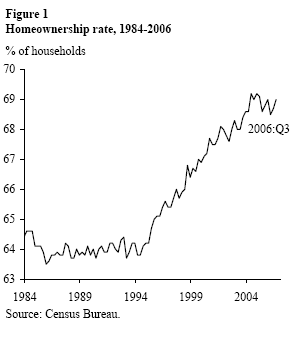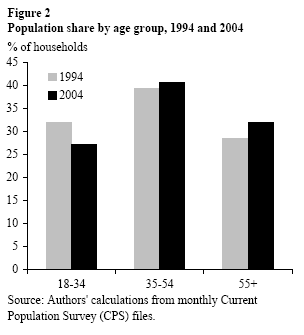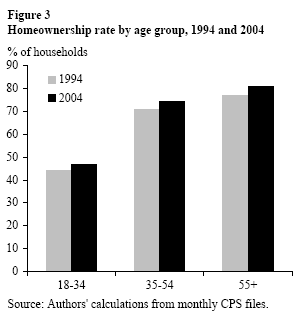After decades of relative stability, the rate of U.S. homeownership began to surge in the mid-1990s, rising from 64% in 1994 to a peak of 69% in 2004, near which it has hovered ever since; this translates into 12 million more homeowners over the period (Figure 1).
- The importance of homeownership and basic facts
- The role of demographic changes
- Other possible explanations
- Conclusion
- References
 After decades of relative stability, the rate of U.S. homeownership began to surge in the mid-1990s, rising from 64% in 1994 to a peak of 69% in 2004, near which it has hovered ever since; this translates into 12 million more homeowners over the period (Figure 1). Understanding the forces behind such trends in homeownership is important not only because supporting homeownership has been an unequivocal public policy goal for decades but also because homes are an important part of people’s net worth and, therefore, can affect their spending, working, and saving decisions.
After decades of relative stability, the rate of U.S. homeownership began to surge in the mid-1990s, rising from 64% in 1994 to a peak of 69% in 2004, near which it has hovered ever since; this translates into 12 million more homeowners over the period (Figure 1). Understanding the forces behind such trends in homeownership is important not only because supporting homeownership has been an unequivocal public policy goal for decades but also because homes are an important part of people’s net worth and, therefore, can affect their spending, working, and saving decisions.
In this Economic Letter, we examine several potential reasons for this surge in the homeownership rate. We find that, while demographic changes have some role to play, it is likely that much of the increase is due to innovations in the mortgage finance industry that may have helped a large number of households buy homes more easily than they could have a decade ago.
The importance of homeownership and basic facts
Homeownership has frequently been cited as an integral feature of the American Dream and, indeed, a host of government policies have been enacted over the decades to encourage it. For instance, the federal government established a number of agencies specifically designed to increase access to credit for purchasing homes, including the Rural Housing Service, the Federal Housing Administration, and the Federal Home Loan Banks. Additionally, homeowners enjoy a host of tax benefits, including deductions for mortgage interest and real estate taxes, as well as a sizable exclusion on capital gains from home sales.
From the homeowner’s point of view, the decisions of whether, when, and how to purchase a home are important, as they significantly affect the household’s balance sheet and other financial decisions. Bucks, Kennickell, and Moore (2006) report that in 2004 primary residences accounted for 32% of total family assets, and the debt secured by those residences accounted for 75% of total family debt. Paying back mortgages and home equity loans can be a significant burden on households; for example, the median household in 2004 with any property debt devoted 17% of its pretax income to servicing that debt (Doms and Motika 2006). The home’s importance as an asset has been especially visible during the recent run-up in house prices, as homeowners have tapped into the increased equity in their homes to boost consumption.
The role of demographic changes


To explore the role of changing demographics in the increase in the U.S. homeownership rate, we first look at broad trends between 1994 and 2004 using data from the Current Population Survey, which is conducted by the Bureau of Labor Statistics. Figure 2 breaks the population into three age groups, and the results confirm the well-known fact that the age distribution has shifted as the baby boom generation has moved up the age scale. Figure 3 shows the changes in homeownership rates within these three age groups, and, as expected, it shows that households headed by older people are more likely to be homeowners; it also shows that homeownership rates increased between 1994 and 2004 for young, middle-aged, and older Americans. Given these data, it seems natural to explore whether the aging of the population or the greater propensity for households within each age category to be homeowners accounts for most of the increase in the overall homeownership rate.
Doms and Krainer (2006) quantify the role of changing demographics by decomposing the increase in the homeownership rate into three components. The first component measures the extent to which the overall homeownership rate would change if each demographic group did not change its propensity to be homeowners, but the share of population in each demographic group did change. The second component asks to what extent the overall homeownership rate would change if the share of each demographic group stayed the same, but their propensity to be homeowners changed. The third component, which tends to be very small in the cases we examined, captures the correlation between the change in the propensity to be a homeowner and the change in the share. (See Doms and Krainer 2006 for more details and precise definitions used in this analysis). The authors find that the first component, the aging of the population, accounts for a little more than one-third of the change in the overall homeownership rate. The second component, the change in homeownership propensity, accounts for almost two-thirds of the change, making this factor about twice as important as the aging of the population in understanding the change in the overall homeownership rate.
Doms and Krainer performed similar decompositions for other demographic characteristics, including educational attainment, marital status, wage income, and the number of children. They found that that the overall increase in the homeownership rate was mainly driven by the increased propensity to be homeowners. Although nearly every demographic slice of the population enjoyed higher home ownership rates in 1994 than in 2004, especially large increases occurred for households headed by people with college degrees and households where the head is unmarried. Thus, changing demographics help explain some of the increase in the overall homeownership rate, but they do not represent the most important piece of the story.
Several factors other than demographic changes may explain the broad-based increases in homeownership rates. Unfortunately, however, there is little research available to quantify their effects; therefore, the ideas in this section are more speculative than the demographic analysis. With that said, it seems plausible that one of the more important factors explaining the broad-based increase in homeownership from 1994 to 2004 could be the myriad of innovations in the mortgage finance industry that occurred during that time, some of which are discussed below and more thoroughly discussed in Doms and Krainer (2006).
Several innovations helped propel the rise of the subprime market during the 1990s and into the 2000s. Although definitions of subprime mortgages vary, in essence they are loans given to households with lower credit quality, and they entail higher than average interest rates. According to Harvard University’s Joint Center for Housing Studies (2006), between 2001 and 2005, the subprime market grew from just $210 billion (in real terms) to $625 billion. It seems probable that the growth in the subprime market has given many households access to credit that would previously have been denied; hence, the increase in the subprime market may have helped boost the homeownership rate.
Growth in the subprime market arose, in part, because of the increased use of credit scoring. Credit scoring is a relatively low-cost technique of assessing the risk of a loan, so it may have made subprime lending decisions cheaper and allowed mortgage lenders to consider a larger volume of high-risk loans.
Another type of innovation in the mortgage industry that may have boosted demand for homeownership is the development of home equity lines of credit and streamlined processes for refinancing. Using these, homeowners can tap the equity from their homes easily and at relatively low costs, thus making the home a more appealing savings vehicle and, consequently, making homeownership more desirable. Also, as discussed in Doms and Krainer (2006), there has been an increase in the array of mortgage products available to consumers, especially products that have low initial payments and low down payment requirements. These products may be especially appealing to consumers who are cash constrained and expect their incomes to increase over time.
Of course, there are reasons beyond innovations in the mortgage industry for homeownership to have increased. For instance, from 2000 to 2004, house prices increased at an attractive 8.7% per year on average; it is possible that homeownership rose in part because some households viewed housing as a good investment. However, there are a couple of reasons to suspect that this “investment” story may not be as important as other stories in understanding the increase in homeownership. For one, the homeownership rate started increasing well before house prices started posting increases that were above their long-term average; for another, the increase in homeownership rates occurred at a time when other investments, namely equities, posted above-average gains.
This list of possible reasons for the increase in homeownership rates is far from exhaustive, but includes some of the most likely suspects. Given the importance that policymakers place on homeownership, and the importance of homes in families’ portfolios, they will be the focus of further research.
The homeownership rate in the United States increased steadily and sharply from 1994 to 2004. A portion of the increase may be due to the aging of the population, but increases in homeownership rates are widespread across many demographic groups, so one must look beyond demographic trends to explain the increase. As this Economic Letter suggests, some of the explanation likely stems from innovations in the mortgage market that resulted in greater access to credit, lower down payment requirements, and easy and low-cost access to the equity in a house, which makes homeownership more attractive.
Mark Doms
Senior Economist
Meryl Motika
Research Associate
References
[URLs accessed October 2006.]
Bucks, Brian K., Arthur B. Kennickell, and Kevin B. Moore. 2006. “Recent Changes in U.S. Family Finances: Evidence from the 2001 and 2004 Survey of Consumer Finances.”Federal Reserve Bulletin 92, pp. A1-A38.
Doms, Mark, and John Krainer. 2006. “Mortgage Market Innovation and Consumer Welfare.” Manuscript.
Doms, Mark, and Meryl Motika. 2006. “Property Debt Burdens.” FRBSF Economic Letter 2006-18 (July 28).
Joint Center for Housing Studies of Harvard. 2006. The State of the Nation’s Housing 2006. Cambridge, MA: Harvard University.
Opinions expressed in FRBSF Economic Letter do not necessarily reflect the views of the management of the Federal Reserve Bank of San Francisco or of the Board of Governors of the Federal Reserve System. This publication is edited by Anita Todd and Karen Barnes. Permission to reprint portions of articles or whole articles must be obtained in writing. Please send editorial comments and requests for reprint permission to research.library@sf.frb.org